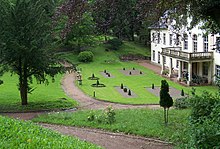Glücksbrunn Palace
The lucky Brunn Castle is a monument in the district Schweina the city of Bad Liebenstein in Wartburgkreis , located in the northeastern part of the town located near the Altensteiner cave .
Glücksbrunn Palace was built in 1703 on behalf of the Dresden court councilor Johann Friedrich Trier . The wealthy court official had achieved a revival of the mining industry around Schweina in 1701 with the purchase of mines and smelting works. As early as 1705, 12 smelters were in operation, and over 100 mine shafts were in operation. The demand for cobalt minerals brought additional profits.
The Glücksbrunn Palace became a secondary residence for the Trier family. By 1780 the copper share of the business had fallen sharply, but the sale of the cobalt minerals was still profitable. As a forward-looking entrepreneur, the Triers parted from their company as early as 1783 and also sold the castle. The Gotha Duke Ernst II appeared as the buyer. The castle initially remained the seat of the Glücksbrunn trade union, which managed the operation of the smelters and mines. After the Sachsen-Meiningen Chamber as the state economic and financial administration took over the ailing operation in 1818, the Glücksbrunn Palace and its ancillary buildings - a garden with a spring and a grotto, as well as the long building (upper mill) with a clock and bells and the copper smelter. Grinding mill (Lindenmühle), forging, stamping mill pond and - on May 8, 1824, the Langensalzaer textile entrepreneur Johann Christian von White sold, the founder of worsted spinning , who was knighted 1836th The existing halls in the castle were rededicated as storage and production rooms, and the combing, laundry and warehouse were housed in the former copper smelter (Lindenmühle). Around 1890 over 400 workers were working for the worsted spinning mill. In 1909 the work came to a nephew of Weiss, the British textile manufacturer Freiherr Henry Joseph Swaine, a farmer in the former Lower Franconian monastery Theres . After further changes of ownership and bankruptcy in the Great Depression , the plant experienced a revival in the 1930s through the merger with the worsted yarn spinning mill located in Niederschmalkalden . The castle was used as a summer residence by Swaine and his family until the end of the Second World War. Emergency apartments were set up in the castle in 1918 (despite being used as a summer residence), and they were used until 1994.
After the end of the Second World War, the building became the property of the community of Schweina. In 1966 the roof of the palace was re-roofed. In 1968 the palace facades were restored. (see Institute for Monument Preservation, 1973, 369) A youth club was set up in the palace in the 1980s.
The castle with park, which is a cultural monument and testimony to the local and industrial history, stood empty from 1994 to 2004. In 2004 and 2005 the Lange Bau, the Lindenmühle and the castle were sold to various private individuals, and extensive restoration work has been carried out on all buildings since then.
Web links
literature
- Edith Raddatz: 300 years of Glücksbrunn Palace . In: Altensteiner Blätter . Yearbook 2003-2004. Schweina, S. 50-58 .
- Ludwig Hertel: Glücksbrunn In: Paul Lehfeldt, Georg Voss (Hrsg.): Architectural and art monuments of Thuringia, Duchy of Saxony-Meiningen. Booklet XXXV, District Court District Salzungen. Jena 1909, p. 105.
- Edith Raddatz: The field names of Schweina . after Erich Oeckel's notes from 1769. In: Altensteiner Blätter . Schweina 1993, p. 64-81 .
- Marienthal. In: Between Ruhla, Bad Liebenstein and Schmalkalden (= values of our homeland . Volume 48). 1st edition. Akademie Verlag, Berlin 1989, pp. 94–95.
- Eduard Fritze : History about Bad Liebenstein, Schweina, Steinbach and Atterode. Edited by Holger Munkel. Reprint of the Eisenach edition, self-published by the author, 1925. Elch Verlag, Bad Liebenstein 1999, ISBN 3-933566-09-6 .
- Roland Geißler : hiking guide to Bad Liebenstein and the Inselsberg. Rockstuhl Verlag, Bad Langensalza 2007, ISBN 978-3-938997-79-6 .
Coordinates: 50 ° 49 ′ 46.3 " N , 10 ° 20 ′ 38.4" E


